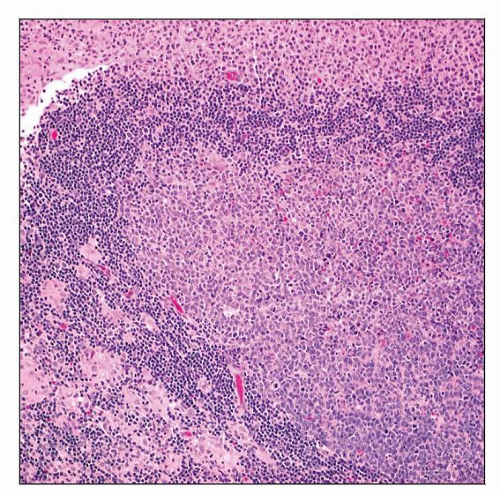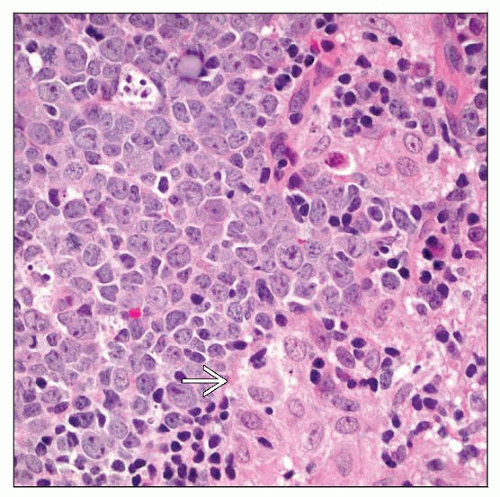Toxoplasma Lymphadenitis
Carlos E. Bueso-Ramos, MD, PhD
Key Facts
Etiology/Pathogenesis
Toxoplasma gondii is parasitic protozoan
Cat is definitive host for sexual stage of reproduction
Oocysts containing trophozoites are generated that are eliminated in feces
Humans and animals are intermediate hosts
Humans ingest oocysts from contaminated soil or undercooked meat
Clinical Issues
Self-limited clinical course in most patients
Children and young adults (65%) most often affected
Unilateral lymphadenopathy, commonly posterior cervical
Microscopic Pathology
Diagnostic triad
Florid reactive follicular hyperplasia
Monocytoid B-cell hyperplasia in sinuses
Epithelioid histiocytes in paracortical areas that encroach into germinal centers
No multinucleated giant cells; no necrosis
Ancillary Tests
Sabin-Feldman dye test
IgM screening antibody test positive in 1st 3 months
Positive Toxoplasma-specific antibodies are detected by enzyme immunoassays
Anti-Toxoplasma immunohistochemistry detects presence of parasites
Toxoplasma genomes can be detected by PCR
 Toxoplasma lymphadenitis. Note enlarged follicles with reactive germinal centers, clusters of epithelioid cells encroaching on lymphoid follicles, and monocytoid cells. |
TERMINOLOGY
Synonyms
Toxoplasmic lymphadenitis
Glandular toxoplasmosis
Piringer-Kuchinka lymphadenopathy
Definitions
Inflammation of lymph node caused by infection by Toxoplasma gondii
ETIOLOGY/PATHOGENESIS
Toxoplasma gondii Infection
T. gondii is protozoan that can invade many cell types
Cat is definitive host for sexual stage of reproduction
Trophozoites reproduce in intestinal epithelium
Oocysts are generated that are eliminated in feces
Humans and animals are intermediate hosts
Ingest oocysts from contaminated soil
Humans can ingest oocysts from undercooked meat
In humans and animals, oocysts are digested by digestive enzymes
Trophozoites are released into intestine
Organisms are carried by macrophages
Spread via lymphatics and blood vessels to internal organs
Within macrophages, trophozoites can multiply and become crescent-shaped tachyzoites
In immunocompetent patients, tachyzoites usually become segregated into cysts synthesized by host
Within cysts, organisms are slow-growing bradyzoites
Infection typically resolves
In immunodeficient patients, tachyzoites widely disseminate, causing acute infection
CLINICAL ISSUES
Epidemiology
Incidence
Toxoplasmosis is common parasitic disease worldwide
More prevalent in warm and humid climates
In USA, toxoplasmosis is most common parasitic infection
50% of USA citizens have serum antibodies to T. gondii: Evidence of chronic infection
T. gondii can be spread transplacentally from mother to fetus
1 in every 1,000 live births in USA
˜ 3,000 births are affected annually
Potential damage to fetus is greatest with infection in 1st trimester
Rarely, T. gondii infection can be transmitted via transplanted organ
Active infection may result from reactivation of earlier infection
Common in patients with cancers and diabetes mellitus
Age
Children and young adults most often affected
Gender
No sex preference
Site
Lymph nodes are commonly affected
Posterior cervical lymph nodes are characteristic site
Often unilateral
Any group of lymph nodes can be involved
Other cervical, supraclavicular, occipital, parotid, intramammary regions
Generalized lymphadenopathy or hepatosplenomegaly can occur but is unusual
Presentation
Asymptomatic infection is common in immunocompetent individuals
Mild illness also can occur manifested by malaise, fever, myalgia
Physical examination of lymph nodes
Tender or nontender
Firm but not rock hard
0.5-3.0 cm
Laboratory Tests
Sabin-Feldman dye test
Highly sensitive and specific
T. gondii organisms do not stain with alkaline methylene blue if they have been exposed to serum anti-T. gondii antibodies
Positive result: Change from negative to positive or rapidly increasing titers
Antibodies to T. gondii can be detected by enzyme immunoassays or indirect immunofluorescence
IgM or IgG antibodies against cell wall antigens
IgM antibodies present within few days after infection
Titers of 1:80 or higher indicate recent infection
IgG antibody titers of 1:1,000 occur at 6-8 weeks after infection
Can persist for years
Latex agglutination test and ELISA assays available
PCR can be used to amplify T. gondii DNA
Stay updated, free articles. Join our Telegram channel

Full access? Get Clinical Tree




